BOOKWORM
Published in Book Reviews, Book Reviews, Issue 2 (March/April 2020), Volume 28By Joe Culley
@TheRealCulls
The only thing bland about this young Irish woman was her name, Lilian Bland. Born in 1878 (in Kent, admittedly) to an affluent family with roots in Antrim, by the turn of the century she was living in Ireland and rebelling against convention in every way. She was, for example, working as a press photographer, concentrating on national hunt, though in 1903 she also covered the inaugural Gordon Bennett road race. And she was one of the first women in Ireland to apply for a jockey’s licence.
In 1909, however, she caught the bug of this new sensation, flying. Not content to observe from the safety of terra firma, she set herself the task of designing, constructing and flying her own plane. By the next year she had done just that, to become the first woman anywhere to do so. And the year after that she just as quickly abandoned this aviation lark, married her cousin and moved to the outer reaches of Vancouver Island to build a frontier homestead—and this a woman who had spent two years in Italy studying music.
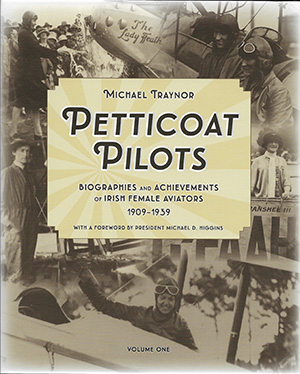 We know all this—and much, much more—thanks to Michael Traynor’s Petticoat pilots: biographies and achievements of Irish female aviators 1909–1939, a most extraordinary and impressive example of self-publishing. In two large, handsome, hardback volumes totalling around 600 pages, including almost 800 images, Traynor tells the stories of twelve trail-blazing women. He spent eight years researching the lives of these women—and I mean lives, because he goes far beyond the narrow focus of aviation to give a complete picture of the societies they came from and the times they lived in.
We know all this—and much, much more—thanks to Michael Traynor’s Petticoat pilots: biographies and achievements of Irish female aviators 1909–1939, a most extraordinary and impressive example of self-publishing. In two large, handsome, hardback volumes totalling around 600 pages, including almost 800 images, Traynor tells the stories of twelve trail-blazing women. He spent eight years researching the lives of these women—and I mean lives, because he goes far beyond the narrow focus of aviation to give a complete picture of the societies they came from and the times they lived in.
To get all of this into print, Traynor somehow managed to get some significant corporate sponsorship, and even an introduction by no less than the president, Michael D. Higgins. The whole project is quite remarkable, and available at petticoatpilots.com. (See HI 18.1, Jan./Feb. 2010, ‘From the files of the DIB’, p. 66.)
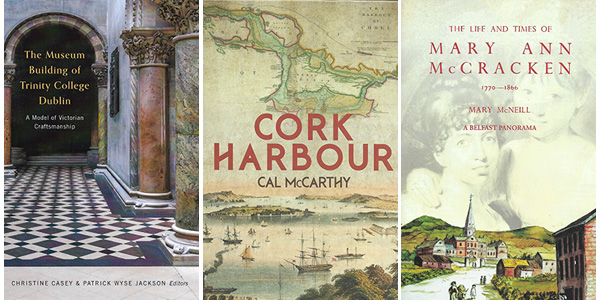
It is only fitting that one of Dublin’s—indeed, Ireland’s—most elegant buildings should finally be celebrated in a beautiful production, The Museum Building of Trinity College Dublin: a model of Victorian craftsmanship. This collection of essays arose in part from a 2018 symposium at Trinity on ‘Making Victorian Dublin’. Interestingly, the book does not focus on the building’s form but rather ‘on the actual making of architecture’. Thus the book’s five sections address materials, quarrying, design, craftsmanship and conservation. It’s a gorgeous hardback from Four Courts Press, which is greatly enhanced by marvellous recent photography by Raymond Keaveney, former director of the National Gallery of Ireland.
Cal McCarthy, the co-author of an excellent history of Spike Island (which we mentioned in HI 24.6, Nov./Dec. 2016, p. 56), has expanded his focus from that bit of land to encompass a history of all of Cork Harbour from the early 1700s to just after the First World War. It’s a fine, nicely illustrated hardback.
McCarthy tackles the story by addressing three main themes: the harbour’s military development; its commercial growth; and, finally, its crucial role in migration. Though the Royal Navy was ostensibly based in Kinsale, as Britain began to ship large numbers of troops to secure its American colonies and fight the French there, the deep waters of Cork Harbour proved more welcoming to the larger ships and their greater number, and the balance of power shifted east. During the American War of Independence, Cork consolidated its reputation as one of the most important harbours in the world. McCarthy’s examination of the port as a centre for both emigration and convict transportation is also full of interesting detail.
To mark the 250th anniversary of the birth of the prominent social reformer and activist Mary Ann McCracken, the Belfast Charitable Society, along with Irish Academic Press, have reissued a 1960 biography, The life and times of Mary Ann McCracken 1770–1866: a Belfast panorama, by Mary McNeill (also that book’s 60th anniversary). The reissue is a lovely hardback.
The author, who was born in 1897 and died in 1984, had followed in her subject’s reforming footsteps and spent her life in volunteer work, particularly in child welfare and education, including helping to establish a nursery school for the city’s poor in 1928.
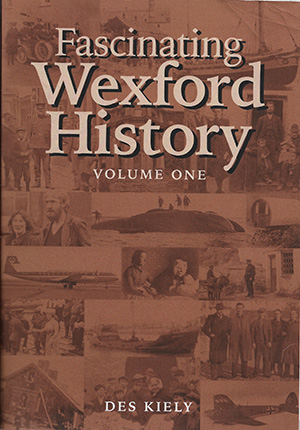 McCracken was, as you may have guessed, the sister of Henry Joy, arguably the most prominent of the northern United Irishmen, but she was herself a formidable presence throughout her long life. She was an early suffragist, an ardent abolitionist and an educationalist. Fortunately, she was also, as McNeill puts it, a ‘fluent correspondent’ in an age of great letter-writing, and it is from this trove that McCracken’s personality emerges.
McCracken was, as you may have guessed, the sister of Henry Joy, arguably the most prominent of the northern United Irishmen, but she was herself a formidable presence throughout her long life. She was an early suffragist, an ardent abolitionist and an educationalist. Fortunately, she was also, as McNeill puts it, a ‘fluent correspondent’ in an age of great letter-writing, and it is from this trove that McCracken’s personality emerges.
Des Kiely has followed his successful Famous Wexford people from last year with Fascinating Wexford history (Volume 1, no less). Kiely knows how to tell a story, and among the 33 brief tales here is that of the £80,000 that went missing from the Colclough estate at Tintern Abbey while it was being administered by one Lt. John Kennedy. The money was never accounted for. Some years later a Patrick Kennedy emigrated to the US, where his grandson became president. Could the missing money …? Another interesting tale is that of the Newtownbarry (now Bunclody) Massacre, when in 1831, during the Tithe War, fourteen people were killed when yeomen opened fire on a crowd protesting the confiscation of two heifers.
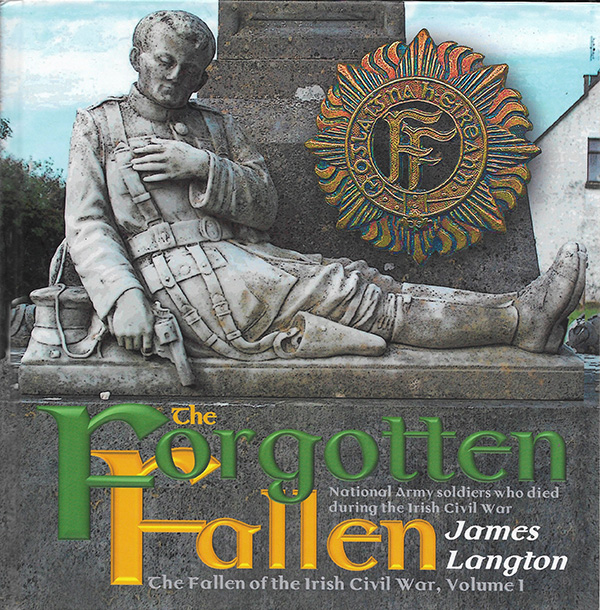
In the first of a planned three-volume series, The forgotten fallen: the fallen of the Irish Civil War, James Langton investigates the stories of some 700 National Army soldiers who died in the conflict. (The subsequent volumes will focus on the anti-Treaty fighters and on the civilians.) Nearly 500 pro-Treaty soldiers died in direct military action, while others died in various incidents. It’s an alphabetical survey, beginning with Private Patrick Acton, who was killed during a search in Kerry, and ending with Captain Jack Young, who was ambushed in the same county. Langton has done an impressive amount of research to try to flesh out the stories both of the men and of the circumstances in which they died. It’s a Kilmainham Tales hardback.
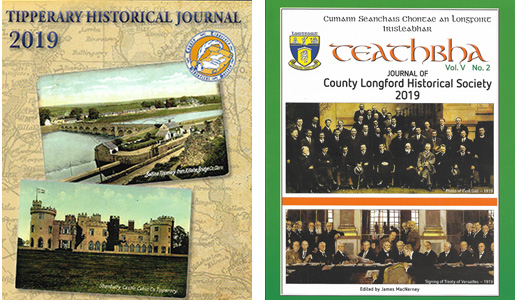
The 2019 Tipperary Historical Journal has an impressive list of eminent contributors, including R.V. Comerford, Willie Nolan and Eunan O’Halpin. Subjects tackled include Daniel Grace’s account of the nineteenth-century father-and-son team of ‘head surgeons’, the Roughans; the 1916 jail journal of O’Halpin’s great-grandfather, P.J. Moloney; and Joachim Fischer’s translation of an Austrian writer’s account of a visit to Lough Derg in 1913.
Up in Longford, Teathbha, the journal of the county historical society, includes J.J. McNamee’s account of Bernard Clarke’s unsuccessful attempt to walk on water.
Michael Traynor, Petticoat pilots: biographies and achievements of Irish female aviators 1909–1939 (2 vols) (self-published, €35 hb, 312pp & 348pp, ISBN 9780954919412 & 9780954919429).
Christine Casey and Patrick Wyse Jackson (eds), The Museum Building of Trinity College, Dublin: a model of Victorian craftsmanship (Four Courts Press, €45 hb, 400pp, ISBN 97811846827891).
Cal McCarthy, Cork Harbour (Merrion Press, €29.95 hb, 300pp, ISBN 9781785373015).
Mary McNeill, The life and times of Mary Ann McCracken 1770–1866: a Belfast panorama (Irish Academic Press, €22.95 hb, 340pp, ISBN 9781788550826).
Des Kiely, Fascinating Wexford history, Vol. 1 (Parsifal Press, €15 pb, 214pp, ISBN 9780993396076).
James Langton, The forgotten fallen: National Army soldiers who died during the Irish Civil War (Kilmainham Tales, €30 hb, 400pp, ISBN 9781908056399).
Tipperary Historical Journal 2019 (€20 pb, 220pp, ISSN 07910655).
James MacNerney (ed.), Teathbha: journal of the County Longford Historical Society 2019, Vol. 5, No. 2 (€12 pb, 110pp).
















